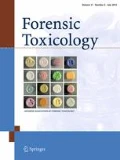Abstract
1-Pentyl-N-(2-phenylpropan-2-yl)-1H-indazole-3-carboxamide (CUMYL-PINACA) is a carboxamide-type synthetic cannabinoid comprising a cumylamine moiety. Recently, the detection of CUMYL-PINACA and some analogs in illicit drug products has been reported by the European Monitoring Centre for Drugs and Drug Addiction. In this study, we synthesized seven cumyl carboxamide-type synthetic cannabinoids (CUMYL-PINACA, CUMYL-5F-PINACA, CUMYL-PICA, CUMYL-5F-PICA, CUMYL-THPINACA, CUMYL-BICA, and CUMYL-5F-P7AICA) and evaluated their activities as CB1 and CB2 receptor agonists. We also showed the analytical characterization of these compounds using gas chromatography–electron ionization-mass spectrometry. All of the evaluated compounds exhibited moderate to strong activities as agonists acting on both CB1 and CB2 receptors with EC50 values in the range of 8.1 × 10−10–7.8 × 10−7 mol/L for CB1 and from 2.5 × 10−10 to 9.1 × 10−6 mol/L for CB2. The EC50 data presented will be helpful to understand the effects of these compounds in the forensic cases. Furthermore, other new cumyl carboxamide-type synthetic cannabinoids, which will be potentially distributed in the future, will probably have the activities as agonists acting on both CB1 and CB2 receptors.



Change history
21 July 2020
There were some mistakes.
References
United Nations Office on Drugs and Crime (UNODC) (2016) World Drug Report 2016. Vienna. www.unodc.org/doc/wdr2016/WORLD_DRUG_REPORT_2016_web.pdf. Accessed 6 April 2017
Kikura-Hanajiri R, Uchiyama N, Kawamura M, Goda Y (2013) Changes in the prevalence of synthetic cannabinoids and cathinone derivatives in Japan until early 2012. Forensic Toxicol 31:44–53
European Monitoring Centre for Drugs and Drug Addiction (EMCDDA)—Europol (2015) EMCDDA–Europol 2014 Annual Report on the implementation of Council Decision 2005/387/JHA. Lisbon. www.emcdda.europa.eu/system/files/publications/1018/TDAN15001ENN.pdf. Accessed 28 April 2017
European Monitoring Centre for Drugs and Drug Addiction (EMCDDA) –Europol (2016) EMCDDA–Europol 2015 Annual Report on the implementation of Council Decision 2005/387/JHA. Lisbon. http://www.emcdda.europa.eu/system/files/publications/2880/TDAS16001ENN.pdf. Accessed 28 April 2017
Dobaja M, Grenc D, Kozelj G, Brvar M (2017) Occupational transdermal poisoning with synthetic cannabinoid cumyl-PINACA. Clin Toxicol 55:193–195
Sveriges Riksdag, Förordning (1999) om förbud mot vissa hälsofarliga varor. https://www.riksdagen.se/sv/dokument-lagar/dokument/svensk-forfattningssamling/forordning-199958-om-forbud-mot-vissa_sfs-1999-58. Accessed 28 April 2017
Ministry of Justice (2017) Pharmaceutical Affairs Law. http://www.japaneselawtranslation.go.jp/law/detail/?id=2766&vm=&re=&new=1. Accessed 28 April 2017
Bowden MJ, Williamson JPB (2014) Cannabinoid compounds. Patent WO 2014/167530 A1
Buchler IP, Hayas MJ, Hegde SG, Hockerman SL, Jones DE, Kortum SW, Rico JG, TenBrink RE, Wu KK (2009) Indazole derivatives. Patent WO 2009/106982
Banister SD, Wilkinson SM, Longworth M, Stuart J, Apetz N, English K, Brooker L, Goebel C, Hibbs DE, Glass M, Connor M, McGregor IS, Kassiou M (2013) The synthesis and pharmacological evaluation of adamantane-derived indoles: cannabimimetic drugs of abuse. ACS Chem Neurosci 4:1081–1092
Asada A, Doi T, Tagami T, Takeda A, Sawabe Y (2017) Isomeric discrimination of synthetic cannabinoids by GC–EI–MS: 1-adamantyl and 2-adamantyl isomers of N-adamantyl carboxamides. Drug Test Anal 9:378–388
Nakajima J, Takahashi M, Uemura N, Sato T, Fukaya H, Suzuki J, Yoshida M, Kusano M, Nakayama H, Zaitsu K, Ishii A, Moriyasu T, Nakae D (2015) Identification of N, N-bis(1-pentylindol-3-yl-carboxy)naphthylamine (BiPICANA) found in an herbal blend product in the Tokyo metropolitan area and its cannabimimetic effects evaluated by in vitro [35S]GTPγS binding assays. Forensic Toxicol 33:84–92
Acknowledgements
This study was partly supported by JSPS KAKENHI Grant number JP25860475 and JP15K08834.
Author information
Authors and Affiliations
Corresponding author
Ethics declarations
Conflict of interest
There are no financial or other relations that could lead to a conflict of interest.
Ethical approval
This article does not contain any studies with human participants or animals performed by any of the authors.
Rights and permissions
About this article
Cite this article
Asada, A., Doi, T., Tagami, T. et al. Cannabimimetic activities of cumyl carboxamide-type synthetic cannabinoids. Forensic Toxicol 36, 170–177 (2018). https://doi.org/10.1007/s11419-017-0374-9
Received:
Accepted:
Published:
Issue Date:
DOI: https://doi.org/10.1007/s11419-017-0374-9

